
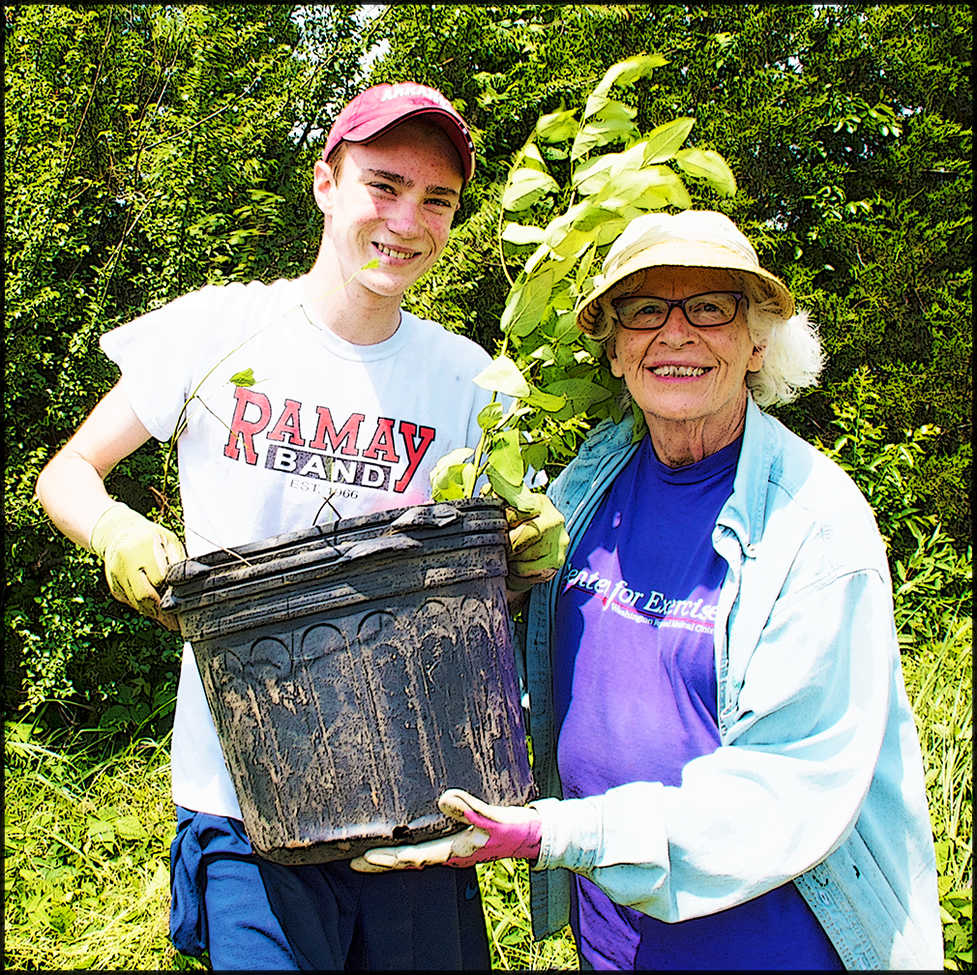
Grandson, Grandmother,
Precious Memories
John Michael McCarthy and his maternal grandmother Dorothy ‘Jean-Jean’ Carney proudly display a dogbane specimen they rescued during the Big Dig Dogbane Rescue Mission mounted by the Arkansas Native Plant Society on the outskirts of Greenland, Arkansas, on Tuesday, May 28. John Michael and ‘Jean-Jean’ have been digging in the dirt since the lad was barely old enough to walk. How special is that!
Image by Crow's Cottage | 28 May 2019
Family, Fellowship
And Rare Dogbane
A Rescue Mission
By Ebenezer Baldwin Bowles
12 June 2019
Growing beside an out-of-the-way lane, hidden from nearby Interstate 540 by a tall stand of eastern red cedars, the rare species of dogbane stood unnoticed by all but a select few gifted with the educated eye of a botanist.
One day, a sharp-eyed botanist stopped to investigate the little colony of dogbane. She surmised it might be a gathering of Apocynum x-floribundum, aka Intermediate dogbane — almost as rare in northwest Arkansas as a vote for Hillary in 2016.
And when the botanist learned that pending real estate development would very likely put the little plants — known in bygone days as bitterroot — under the mower's cruel blades, a series of actions began to unfold within a tightly-knit circle of Natural State environmentalists and ecologists — leading, ultimately, to the Big Dig Dogbane Rescue Mission of 2019.
Thank Gaea, I was there … to do a little digging with the rescue squad, enjoy the fresh springtime breeze, and privately celebrate the blessings of fellowship. It was there, also, that I met John Michael and his grandmother Jean-Jean. So, here's their story, and a couple of others, too, all engendered by an especially mellow day at the end of May when family, botany, idealism, collective action, and comradeship came together to create a special memory.

Loyal to the Bitter(root) End
These hardy members of the Big Dig Dogbane Rescue Squad persevered 'till the mission was done. Other volunteers did their dutiful digging in Greenland and then moved on to other worthy pursuits. Posing in front of the ADOT trailer a few hours after noon in the backwoods of Benton County near Healing Springs, squad members are aglow with the good feeling that comes from fellowship and a job well done. John Michael McCarthy stands to the far left, next to Master Naturalist extraordinaire Ralph E. Weber of Bentonville. Next is line is the affable Deb Shoemaker. Squad leader Jennifer Ogle leans against the trailer next to newly ordained Master Naturalist Rose Tacker, who holds a dogbane. And here your editor must admit to a failure of journalistic due diligence: We can't identify the three dedicated environmentalists in the center. Can you help? We do know that the tall man in orange is Eric Sanders of Little Rock, the Arkansas Department of Transportation wrangler who drove up from the Capitol City to provide the trailer. Dorothy Carney stands to his left next to Master Naturalist and uber volunteer Steve Sampers of Garfield. Anchoring the group on the far right of our portrait is Fayetteville's own Alan Ostner.
Image by Crow's Cottage | 28 May 2019
It Began with a Tree
“Since he was tiny, he loved to get into the garden,” Dorothy Jean Carney said of her grandson, born fifteen years ago to her daughter Susan. “He learned to plant. He learned all the names of the plants. And he identified the bugs and the things that eat them. John Michael and I were the gardeners together, providing food for the family.”
“She's a massive inspiration,” John Michael McCarthy said of his grandmother, who he calls Jean-Jean. “She is always there. We go on walks together. When I was little, she had a bird feeder outside and we would identify birds together.”
One of John Michael's earliest memories is also the genesis of his passion for the natural world. “It started when my grandmother and I planted pine trees at her house. She bought me a red bucket and I would go around with the pine trees, helping put them in the ground. Later, when she built a garden, I helped with that. I thought, ‘Man, when I grow up I want to do something with plants.’ ”
“He had a little wheelbarrow," Dorothy recalled. “I bought him a little set with a shovel, rake, and wheelbarrow. He was tiny, maybe not quite two at the time. He could walk pretty well but that was about it. We put pine trees, little seedlings, in the wheelbarrow, and John Michael had his shovel, and he was putting pine trees in the ground.”
And, It Takes a Village.
(It Does!)
Others helped, too, as John Michael began to grow into an exceptional young naturalist. Dorothy's fellow Master Gardener Robin Buff — “She loves John Michael,” Dorothy said — became a devoted mentor, taking him to Audubon Camp in the summertime and paving the way for him to become a member of the Arkansas Native Plant Society. John Michael wanted to become an Arkansas Master Naturalist but age restrictions (18 or older) got in the way. The Native Plant Society offered the ideal alternative, so he signed-on as one of its youngest members.
No longer tiny, John Michael stands over six-feet tall and harbors big ambitions. A soon-to-be sophomore at Fayetteville High School, he plans to apply to Cal-Poly's environmental engineering program — “It's number one in the nation,” he said — and eventually pursue a law degree, specializing in environmental issues. “It's the best way I can think of to get into the whole environmental mess right now,” he said. Let's hope he can help clean it up, this global ecological mess we've created for generations to fix. Young citizens like John Michael give some reason for hope.

Look Inside! Love that Stigma!
Close-up, the dogbane flower left of center in our image reveals a fascinating orange, five-petaled stigma, looking very much like a flower within a flower. We were fortunate to find a dogbane blossom staring directly back at us — they are droopy by nature, but this one rides high atop a cluster of buds at the junction of a twig, presenting an opportunity to peek inside. No doubt the striking orange quinate petals serve their purpose of enticing pollinators to stop for a visit. Though we neglected to bring our ruler to the field, we can safely estimate that the little orange jewel of a stigma is less than two centimeters in diameter. BTW, can you spy the insect? Look for black stripes on blue.
Image by Crow's Cottage | 31 May 2019
A New Home for a Rare Species
One of John Michael's cohorts in the Native Plant Society, Jennifer Ogle, is the sharp-eyed botanist mentioned at the beginning of our tale. “I found the plants,” she said. “I'm pretty sure they're Intermediate dogbane, rare in Arkansas.”
The dogbane lives along an obscure backroad called Campbell Loop, less than a mile south of West Wilson Street in Greenland. “They turned out to be on highway department property,” Jennifer said. “The property next to the area where this population occurs is about to be developed, and the owner tells me he plans to regularly mow the area where the plants are growing. So I contacted Kayti Ewing at the Arkansas Department of Transportation (ADOT), and she agreed they needed to be rescued.”
Ms. Ewing, a highway department botanist and devoted champion of monarch butterfly conservation, found a new home for the dogbane on a sweet tract of land along Osage Creek in Benton County. The land, once ago the home to an ambitious family farm, was acquired by ADOT during a mitigated wetland settlement some years ago — offering an ideal solution to the mission of native plant preservation.
Walk with Me on the Sunny Side.
Though some will disagree, ADOT has long demonstrated a commitment to helping establish and protect wildflowers along several of the state's major and lesser highways. We've heard complaints about aggressive mowing operations, but today we prefer to walk on the sunny side and watch for the emergence of native (OK, mostly native) summer flora sown along a thousand miles of state roads by ADOT's Operation Wildflower — Carolina Larkspur, Black-eyed Susan, Pale Purple Coneflower, Indian Paintbrush, Spider Lily, and Rough Blazing Star among a constellation of dozens of colorful species. One of our favorites here at Crow's Cottage is the humble and prolific Queen Ann's Lace, ancestor of the dining-table carrot.
“We have an active program where we mark native wildflower areas on ADOT property,” Jennifer said. “We work together in a relationship that began in the 1990s under the guidance of Carl Hunter, who wrote the wildflower book (Wildflowers of Arkansas | Ozark Society 1984) and the tree book (Trees, Shrubs, and Vines of Arkansas | Ozark Society 1989). Carl (1923-2005) helped establish the connection between the Native Plant Society and the highway department, and Kayti revived it when she began work with the department. She's always onboard whenever we call with a report about native plant preservation.”
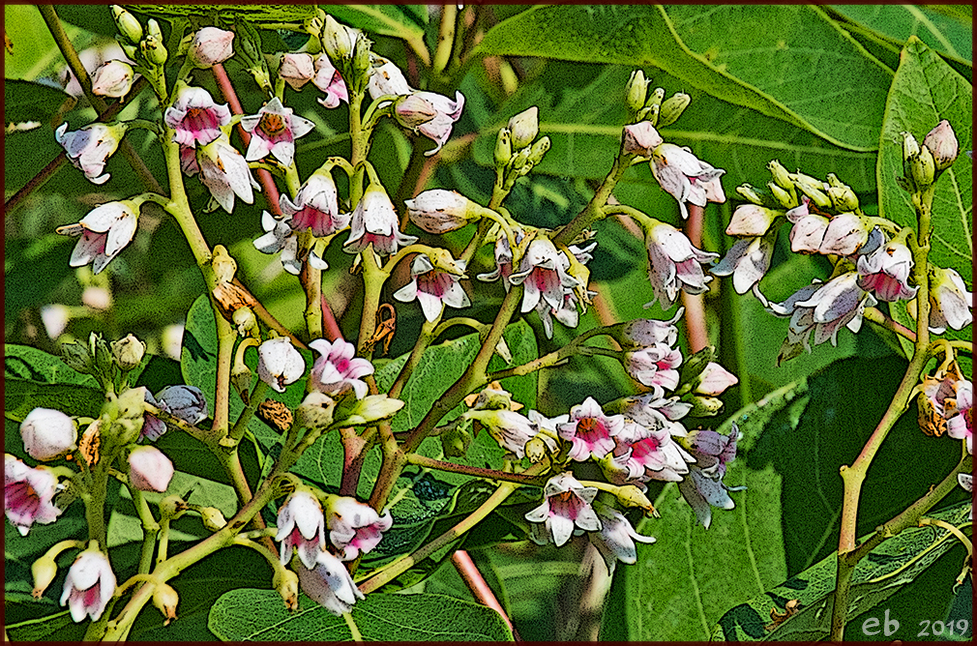
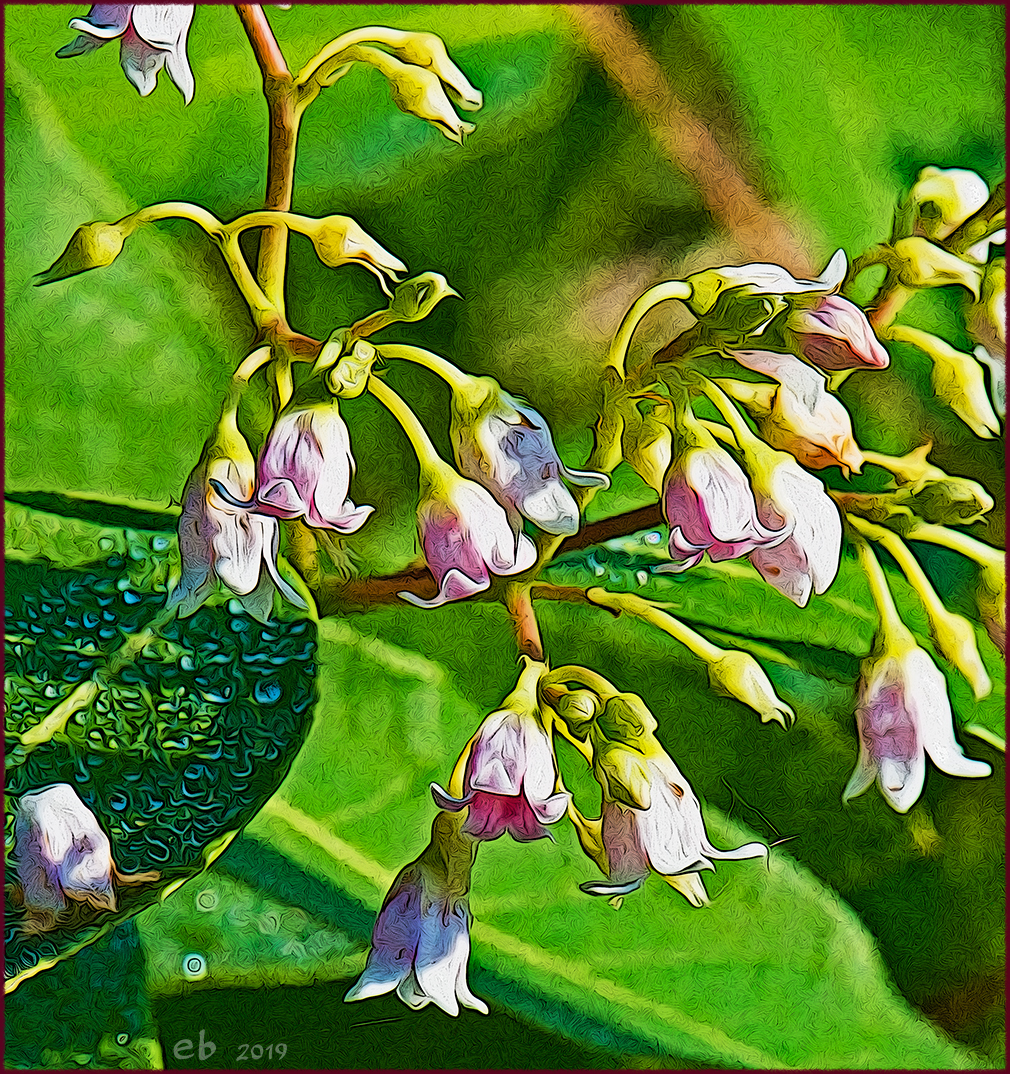
In Search of Essence
At a glance, looking casually from afar, the dogbane isn't one of nature's stunning beauties. The flowers are small and droopy — and they tend to get lost amid the large leaves of the plant and the chaotic structure of the colony. Yet, every wondrous thing in nature exhibits special characteristics to differentiate it from all the others — and frankly, Beauty can be found when one opens an inner eye to search for her. If not beauty, then for sure the essence of a living thing can be discovered. Here at Crow's Cottage, our imagist's eye favors form and color in quest of the visual essence of flora — the notion of the object being observed — especially in the myriad ways she presents flowers and leaves to the Universe. Bathed in the early morning light of the last day of May, with droplets of dew clinging to a few of the leaves, these specimens show us first the wider cluster of flowers, buds, branches, and leaves, and then a closer look at the pale shades of pink and rose on petals of dogbane's droopy flowers. The shades of greenish yellow on the buds and branches, and the deep green background of leaves complete the display, which pleases us. How about you?
Image by Crow's Cottage | 31 May 2019
Consternation, Doubt,
And Good Ole Sense
Intermediate dogbane, the botanist's Apocynum x-floribundum, is a hybrid of Spreading dogbane, Apocynum androsaemifolium, and Hemp dogbane, Apocynum cannabinum. Like many hybrids, she's not always easy to identify — a state of being leading to consternation and doubt among experts in the field and the laboratory. Ever the professional, Jennifer hedged her bets when we discussed the identity of the specimens we collected during the rescue mission.
“The dogbanes are really unusual,” she said. “The milkweeds are unusual, too. They have a weird floral structure — different than most other flowers. They're just odd.” The specimens we dug up along Campbell Loop, she surmised, were either Intermediate or Spreading. “If you look at the sepals, those lobes are longer than they should be, and that would make it the hybrid. I'm not a hundred percent certain it's the hybrid. It's just hard to know in the field. But I believe it's of the rare variety, so it made good sense to go ahead and collect them.”
How rare in the Natural State? The Arkansas Natural Heritage Commission's online search engine for “Arkansas Species of Conservation Interest” tells us that, current to September 2015, Intermediate dogbane was found in only two counties: Logan and Polk. Spreading dogbane was identified in Washington, Van Buren, and Logan Counties.
A study by botanists at the University of Colorado at Denver explored the uncertainty surrounding the hybrid, noting that skeptics “called into question” the very existence of x-floribundum because “observations of numerous insect visitors reveal that pollen is not routinely carried from flower to flower,” thus hindering the “import and export of pollen” and restricting reproductive success. Professors Johnson Bruederle and Tomback's conclusions, however, supported "the hypothesis of hybridization," noting that the "persistence and vegetative spread of hybrid clones may contribute to the illusion that hybridization is common.” [A Mating System Conundrum: Hybridization in Apocynum | Vol. 85 Issue 9 of the American Journal of Botany 1998].
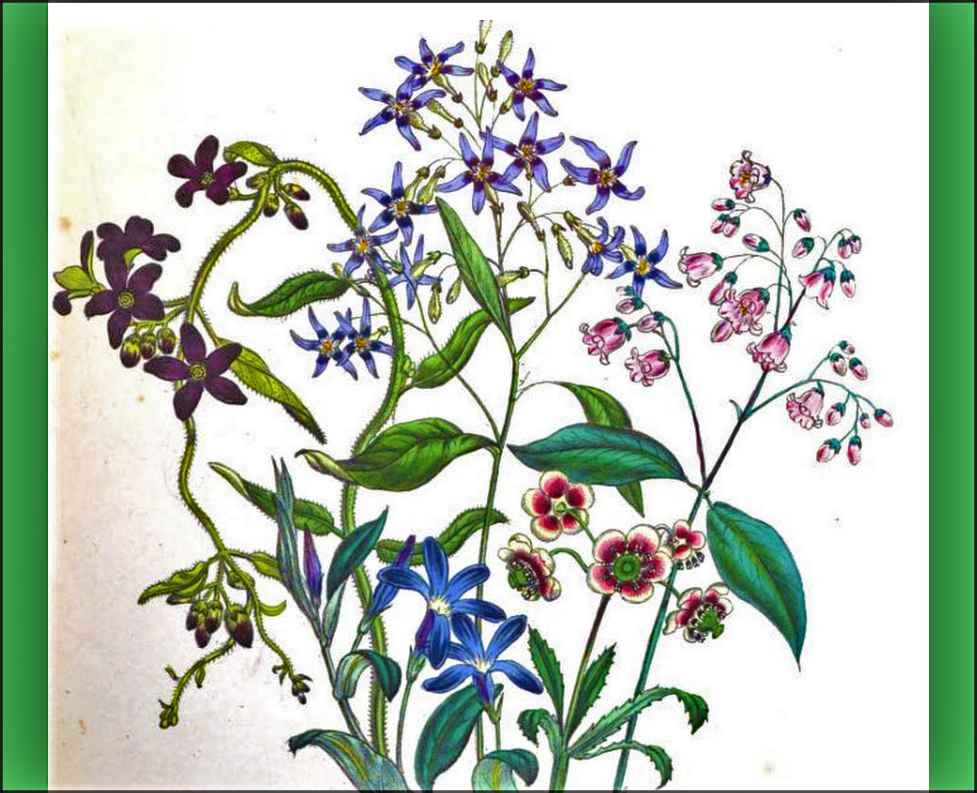
The Dog's-Bane
“This genus was well known to the ancients and it was called Apocynum by Dioscorides, which signifies literally ‘dog's bane,’ because it was supposed to be peculiarly injurious to dogs,” Mrs. Jane Loudon wrote in The Ladies' Flower-Garden of Ornamental Perennials, Volume II, published by William Smith of London in 1844. Don't let the precious title trick you. Mrs. Loudon's text is informed, erudite, and precise. Her paintings are exquisite. The one reproduced here displays Apocynum androsaemifolium on the far right in a collage also showing (from left) “The Umbellated Winter-green, The Herbaceous Periwinkle, The Hairy Gonolobus, and the Broad-leaved Amsonia.” We're fortunate to have one of those early spring blue amsonias growing in the gardens here at Crow's Cottage.
Drawing by Mrs. Loudon | 1844
Steer Clear of Laxative Spiced Bitters.
We'd love to tell you about why the early Thomsonians of the mid-nineteenth century called the dogbane “bitter root” … and about how the New England Scotsman, chemist, herbalist, and botanist Samuel Thomson (1769-1843) mixed dogbane extract into his tonics, especially the “Laxative Spiced Bitters” sold at medicine shows — imagine copious vomiting and purging and you'll be on the right track — and that according to Dr. Bigelow, “the taste of the milky juice, which exudes when any part of the plant is wounded, is unpleasant and intensely bitter” … or that the powder of recently dried roots was administered long, long ago as a remedy for lucs venera … but the hour is growing late and we must bring this tale to a conclusion before the wolves begin to howl in the dark night.
However, I shall tell you by way of aside that dogbane grows in far-flung lands on the planet, hence the cryptic entry about long life and posterity at the very top of our page from the Journal of North-China Branch of the Royal Asiatic Society (1885). Here in North America, the ancient plant “is found in open woods, along fence rows, and in old orchards throughout the United States,” according to The Peterson Magazine of January-June 1880. Canada, too. And back in the Orient, dogbane, I'm told by a Daoist, attracts love but not luck. O, to be lucky in love!

First Prize Hands Down
Squad leader Jennifer urged us to dig deep and extract as much root structure as possible. Had we engaged in a contest, squad member Alan Ostner would have won hands down when he dug-up this awesome specimen. Alan did win a prize, however, when Northwest Arkansas Democrat Gazette photographer Andy Shupe selected him as the public face of the rescue mission and published Alan's image — holding the same long root shown above — on page 5B of the May 29 edition. Thanks, Andy, for making the trek to Greenland and inscribing the Big Dig Dogbane Rescue Mission into the annals of recorded history. Andy's photo, BTW, caught Alan in full stride — a real-time action shot worthy of a talented pro photographer.
Image by Crow's Cottage | 28 May 2019
It Ended with a Tree.
At the Big Dig, about twenty of us volunteers worked for two hours, coaxing fifty or so specimens from the hard, rocky soil and depositing them in black plastic vessels, which were then placed in the ADOT trailer for transport to the abandoned farm site just west of Cave Springs along State Highway 264, thirty miles away.
The rescue crew roster for phase one of the operation included Eric Sanders of Little Rock, Jennifer Ogle of Greenland, Pedro Cannon of Fayetteville, Deb Shoemaker of Bella Vista, Tina Denney of Garfield, Alan Ostner of Fayetteville, Ralph E. Weber of Bentonville, Steve Sampers of Garfield, Elizabeth Hale of West Fork, Angie Cope of Decatur, Rose Tacker of Fayetteville, Susan Bolding of West Fork, Vicki Hall of Nogo (yes, there is a tiny unincorporated hamlet by that name just outside Russellville), and Jean-Jean and her grandson. To my dismay, I neglected to record everyone's name — my scribe's skills are way rusty — so if you're reading this paragraph and were one of the squad, please write and I'll insert your name to complete the circle.
Most of us moved on to phase two, the planting. A few others were called elsewhere in the press of the day. We regrouped in Cave Springs and headed to the farm.
Alas, an act of God, as the insurance men say, kept us from completing our mission on the sunny afternoon of the twenty-eighth day of May. As we drove in a ragged convoy up the narrow, bumpy dirt road winding through the abandoned farm — the road leading to the isolated garden site for our dogbane — we came across an insurmountable barrier in the form of a fallen oak blocking the way. On the last mile in the last hour, we were thwarted.
Can't say we were overly disappointed. The dogbane, we figured, was robust enough to survive until Jennifer and Kayti could devise a plan to complete the mission. Either we move the tree, or change the garden site, alternatives that couldn't be settled right there on the spot. The state by nature has its rules and we weren't about to break 'em.
Eric maneuvered the trailer to a shaded spot next to a rickety shed along the south-facing bottom lip of a ridge whose north face rises above Osage Creek. One by one, we lifted the dogbane-laden vessels out of the trailer and set them in loosely formed rows under the tall, shaded canopy of healthy native trees. The weather forecast called for overnight rain. We visited and laughed and paused for the group photo, then went our separate ways.
Why do we do this? Why do we mount an expedition on behalf of a half-hundred plants? I asked Jennifer the next day. “Because of the rarity of it,” she began. “Any time a plant is tracked by the state as being rare for one reason or another, we try to take action. Oftentimes it's rare because of our activity. Sometimes it's natural rarity. Maybe natural climate change. But more often than not, it's due to human disturbance and changes. So it's important that we take responsibility as much as we can and save what we can.”
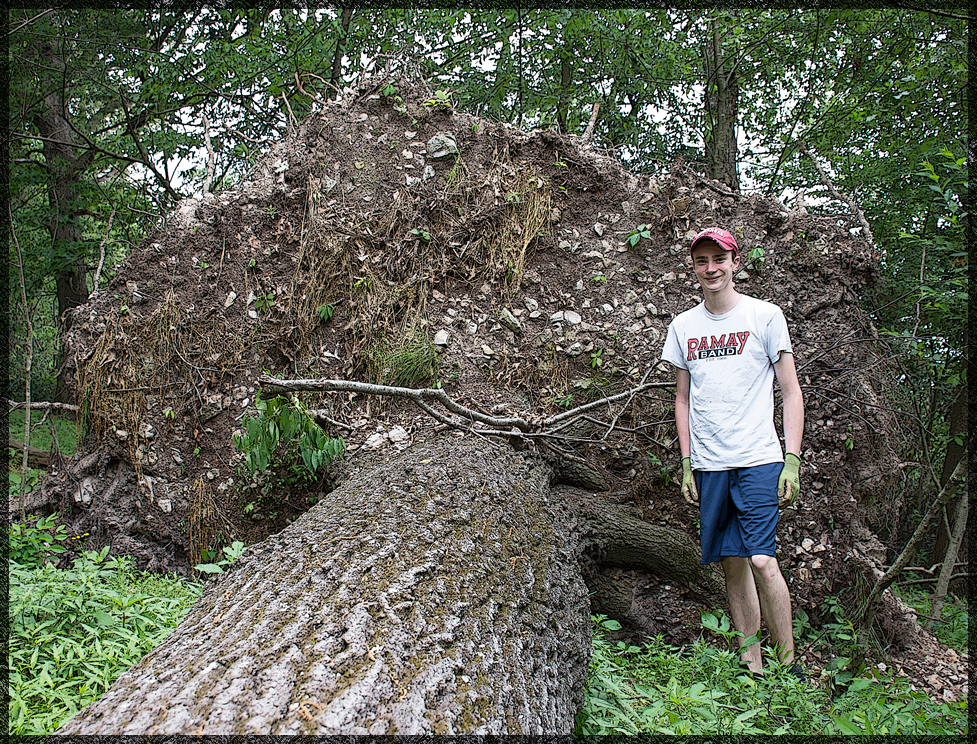
A Fallen Giant Blocks the Way
Our plan to plant the rescued dogbane at the designated site atop a hill overlooking Osage Creek was thwarted by a fallen oak, a very tall and hoary giant whose aged roots could not withstand the strong wind and soggy soil of May's incessant thunderstorms and epic rainfall. The oak's great form blocked the narrow, rocky road leading to our destination — and there was no way around. The leaves of the oak were still green, but I neglected to identify the species nor measure the giant's girth and height. John Michael, standing just over six feet, is not nearly as tall as the root ball, which left a deep pit in the red earth on the other side of our vantage point.
Image by Crow's Cottage | 28 May 2019
‘I Can See Them Now’
Jennifer's answer about the reasons why resonate here tonight, which is perhaps why I asked. The whys come to mind often nowadays. Like many, I'm searching.
I've been wondering why I decided two seasons ago to wander away from the splendid isolation of my country home and join a little band of idealistic naturalists and gardeners, some of them quiet dreamers and others committed activists, to participate in the grand mission of environmental stewardship. The decision makes sense in theory because I know our environment needs humanity's help, but going OUT THERE to engage in the sometimes messy and always demanding arena of civic life is a personal challenge beyond any obvious measure. Frankly, I find the world of women and men intimidating, not because of my fellows but because of something missing deep within. I never can get it quite right.
All the while, I refuse to give up. Like young John Michael a dozen years ago, planting pine trees in the ground with his grandmother, I prefer to walk on the sunny side of hope. That's why, I suppose, I joined my fellow volunteers and dug up dogbane to save it from the mower's blade. I hope the colony thrives in its new home high on the ridge beside the creek. I got to meet some new folks, renew ties with others, and traipse around the outdoors. Along the way I won a new, nice memory.
“It's been real special all the way around,” Dorothy Jean said when we talked about her close relationship with John Michael and what it means to dig in the dirt with him now that he is becoming a man. “My two daughters and their families live on land next to mine. We all have separate driveways. We can't really see each other's homes, but we have little paths that run back and forth to each other's houses.
“John Michael has an older brother and sister, and they played together all the time when they were little. They had a couple of cousins, too. I used to be able to look out there in the back of my house — the back of my house is a pasture.…” Dorothy Jean paused for a second. "I can see them now, running and playing out there. Great memory."


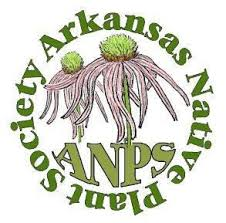
We wish we could match the camera eye of photographers who post on the blog of the Arkansas Native Plant Society. Their botanical illustrations and text are absolutely superb and finely attuned to the wonders of the natural realm. A great resource on multiple levels! Go see.
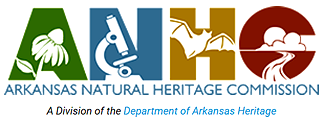
The Arkansas Natural Heritage Commission has it goin' on when it comes to collaborative conservation, scientific research, and the protection of special places. You won't find a deeper, more comprehensive web about environmental issues and opportunities here in the Natural State.
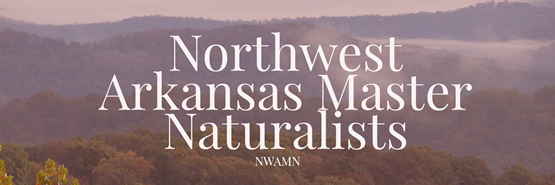
The Northwest Arkansas Master Naturalists dispatched several volunteers to the Big Dig Dogbane Rescue Mission. JB Portillo and Cheryl Larson are busy developing a new web for the organization, which has members in Benton County, Washington County, Madison County, and Carroll County. No other organization in our state provides more volunteers than the statewide Arkansas Master Naturalists. We invite you to take and look and think about adding your labor and expertise to the cause.

“A Natural Promise: Embracing Hope” is Crow's Cottage feature about the Arkansas Native Seed Program. Inspired by the Beaver Watershed Alliance's Quarterly Speaker Series at the West Fork Library in February, the essay calls on environmental leaders Jennifer Ogle, Clell Ford, Dave Leisure, and Jonathan Young to tell the story of a very important initiative of conservation and preservation.
As always, we invite you to write us letter of encouragement or correction. You can even chastise us if you're respectful. Expect a courteous and timely reply. And let us know if you'd like to receive a notice about new features. Our address is ebenezer@crowscottage.com



